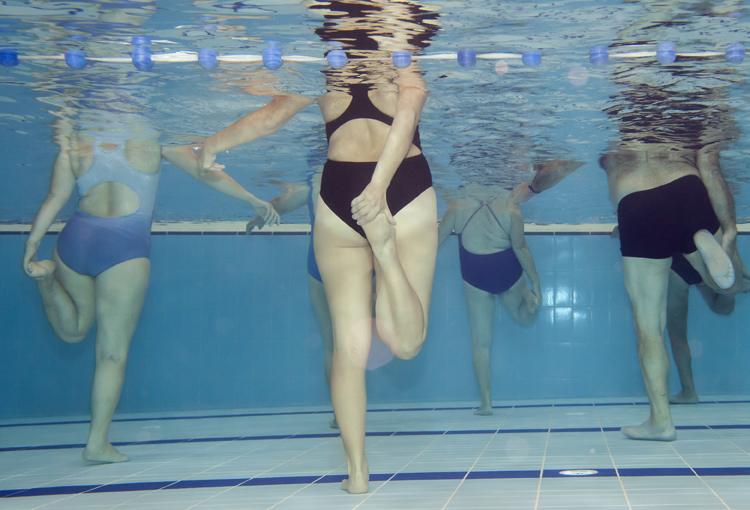Frances Leckie, editor of Independent Living, takes a look at the therapeutic benefits of water. Frances is a “DH Guru” who’ll be sharing a monthly column on independent living!
#DHgurus
In the unlikely event that I ever win big on the lottery, or acquire a serious amount of money in some other equally unfeasible manner, I know exactly where the first chunk will go: an indoor swimming pool of my own. Indoor because I am a wimp, and take no pleasure in the idea of a bracing plunge into cold water, however wonderful it might allegedly feel once you get used to it. And privacy is quite a bonus, too. Swimming on your own, without having to dodge lots of other people who travel much faster, or just seem to spread themselves into the same space you’re aiming for, is so much more enjoyable. Leaving my personal daydream to one side, I’d like to look at some of the therapeutic benefits of water therapy, and aids to make it more accessible to all.
The local swimming pool is probably where most of us hit the water, and in addition to swimming sessions, they generally provide aquatic classes – water-based exercises to improve muscle strength, flexibility and balance, or achieve a cardio workout. Exercising in water means that your body weight is supported, relieving stress on the joints. Some people find their range of movement is increased, and mobility impairments that make it very difficult or impossible to walk may well be much less inhibiting in water.
Interesting new aquatic therapies
Ai Chi is a form of aquatic exercise which aims to both relax and strengthen the body, by combining breathing techniques with progressive resistance training. It is usually practiced in warm water up to your shoulders, and was developed in the 1990s using elements of qigong and tai chi chuan. Encouragingly, people with painful conditions who practice Ai Chi have found their pain diminished: a study involving people with MS found reductions in both pain and spasms, well beyond the benefits achieved by those performing similar exercises and breathing techniques in the therapy room.
Watsu or Water Shiatsu is another interesting possibility, combining treatment of acupressure points and shiatsu massage with gentle stretches, using the lightness of the body in water to free the spine, rotate joints and lengthen muscles. Unlike Ai Chi, which can be practiced in classes, Watsu is a one-to-one aquatic therapy.
Access to water-based therapy
Both of these water-based therapies are comparatively new, and are not yet widely available around the country, but if you try a Google search for either term, you will come up with qualified practitioners in various areas – you might be lucky enough to find one near you! Happily, the general concept of aquatic therapy or hydrotherapy is now well established, and there are many physiotherapists who specialise in water-based treatments. You can make a postcode search on the Chartered Society of Physiotherapy website http://www.csp.org.uk/. Unfortunately, as you are probably all too well aware, the chance of an adult obtaining physiotherapy through the NHS, except for a short period of rehabilitation following injury or illness, is extremely slim. So access to aquatic therapy sessions will depend on an individual’s ability to pay: another example of the extra costs of living with a disability. One-to-one sessions lasting half an hour cost an average of £30 – £70. In some areas, you may be lucky enough to find group sessions, which are much more affordable.
Reducing fatigue
Many long-term conditions bring fatigue, which has such a wide-ranging impact on life it’s hard to know where to begin. Nevertheless, studies have shown that regular aerobic exercise, such as swimming, can help to reduce fatigue, boosting the amount of energy you have for other activities, and improving the way you feel psychologically too. It seems counterintuitive, to do something that requires effort when you feel exhausted, but it works!
Swimming pools for wheelchair users
Of course you first need to get into the pool – and this can be quite a challenge for wheelchair users. Sadly, despite the best efforts of the equality legislation – DDA followed by the Equality Act 2010 – you cannot count on there being a hoist at every pool to get you into the water. For interest, I checked on the useful “Poolfinder” website http://www.swimming.org/poolfinder where you can search for pools in your neighbourhood by postcode. There are four public swimming pools within a mile of where I am at the moment, but the nearest one listed with disabled access is more than 40 miles away. Obviously the situation will vary around the country, but that does illustrate one of the problems people may find in embracing water therapy.
Where wheelchair access is provided, you may find that getting into the pool involves transferring from your chair to a poolside hoist to get into the water. If you are lucky enough to be within reach of the London 2012 Aquatic Centre, the Commonwealth Games pool in Glasgow, or a few other strategic locations around the UK, you may be able to benefit from a Poolpod, which provides independent access via a submersible lift platform which takes a wheelchair, or indeed an ambulant user, and lets you lower yourself into the water. You can then call the lift back down when you want to leave the pool, all controlled with an access wristband, so that the process can be managed independently.
Water therapy at home
Does your home boast a stylish modern wet room, or are you fortunate enough to have a bath tub? Many of us have opted for the speed, convenience and easier access possibilities of a shower, but the therapeutic benefits of a soak in the bath have perhaps been overlooked. With tubs that provide for side access from a wheelchair, or have an integrated chair lift to lower you into the water, it is still possible to enjoy some home therapy, relaxing muscles and aching joints, perhaps adding some delicious-smelling essential oils to the water, such as lavender or chamomile, to help promote sleep. A tub with massage jets, like a Jacuzzi, is clearly a luxury facility, but also one that brings considerable therapeutic advantages, for anyone in the fortunate position of being able to afford one.
The other water therapy!
Finally, while I was researching this article, I came across another type of water therapy which certainly deserves a mention, and won’t require any effort or expenditure. Drinking the stuff! Start your day with a large glass of pure water, as the very first item in your morning routine, then make sure that you keep properly hydrated, and I can guarantee you will feel better. I would approach some of the more evangelical websites advocating “Japanese water therapy” with extreme caution. In the first place, they often recommend consuming rather alarming quantities of water – and too much is definitely as bad as too little. Secondly, they claim that it cures all sorts of illnesses, which it obviously doesn’t. What it will do, is help with things like constipation, indigestion and urinary tract infections, and make you feel more energetic. Which seems to me enough reason to give it a go!
By Frances Leckie
Disability Horizons




